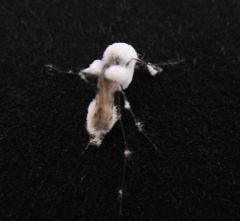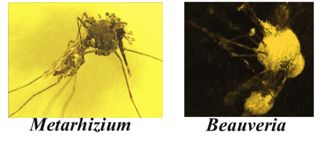Curing Mosquitoes of Malaria
Air Date: Week of March 4, 2011

A mosquito infected by the insect pathogenic fungus. (Raymond St. Leger)
Organizations around the world have been trying to battle malaria with insecticides. But evolution has taken its course, and now many mosquitoes are building a resistance to these efforts. Host Bruce Gellerman talks with Raymond St. Leger, an entomologist at the University of Maryland, about his new research that uses a transgenic fungus to attack the malaria parasite inside of the mosquito, before it has a chance to bite a human.
Transcript
GELLERMAN: Malaria is an insidious disease. It destroys lives and undermines the development of poor nations. Mosquitoes carrying a parasite that causes malaria infect nearly a half a billion people a year, mostly in the tropics. Annually more than a million people die from malaria. Most are children.
Mosquito nets and pesticides help, but at best, the battle against malaria is at a standoff. Now scientists have developed a new way of destroying the parasite that causes the disease, and joining me is the researcher who led the effort. Professor Raymond St. Leger is an entomologist at the University of Maryland. Professor, welcome to Living on Earth.
ST. LEGER: Thank you very much.
GELLERMAN: As I understand it, you’re using a genetically modified fungus to kill the malaria parasite. Which fungus, and how does it work?

Dr. Raymond J St. Leger used scorpin, a toxin found in the Imperial Scorpion’s venom, to cure mosquitoes of malaria. (Raymond St. Leger)
ST. LEGER: Yes, we are. It’s a fungus called Metarhizium anisopliae, and it infects insects through their skin. And, what we’ve done is we’ve taken a gene encoding a human antibody, and we also tried a gene encoding an anti-malarial toxin, and we put those genes inside the fungus. And so now we’ve got a fungus that acts like a contact insecticide.
It lands on the insect’s skin, penetrates into the blood of the insect, and then will produce human antibody against the malaria, and basically cure the mosquito of malaria within a couple of days of infection.
GELLRMAN: But you didn’t want to kill the mosquito, you want to kill the parasite that carries the malaria. Why wouldn’t you want to kill the mosquito?
ST. LEGER: Well, we can kill the mosquito. We can engineer the fungus to express insecticidal toxins from a spider, and they’ll kill a mosquito in a couple of days. But the problem we might have then is, the likelihood is that the insects will evolve resistance to the fungus as well. So we wanted to change the strategy: target the malaria inside the mosquito.

Mosquitoes infected by two different insect pathogenic fungi. (Raymond St. Leger)
GELLERMAN: Now you’re genetically modifying the fungus with a scorpion toxin. How’d you come up with that?
ST. LEGER: Ah, well, that’s scorpine as it’s called - it’s a toxin which has been studied for a few years now by different groups. And, it’s quite interesting - it’s an antimicrobial toxin, and it was shown to be effective against plasmodium a couple of years back. Now the scorpine toxin is from the Imperial Scorpion, a great big scorpion, a huge scorpion in fact, which has got a rather placid personality, plays well with children.
GELLERMAN: And I guess saves their lives.
ST. LEGER: Yes, this scorpine toxin could actually save lives, just by putting it in the right place. And the fungus is our tool and utensil for doing that. It’s the delivery system.
GELLERMAN: So how do you get the fungus into the mosquito?
ST. LEGER: The fungus can be applied like any chemical could be: You could spray it or you could put it on a cloth in the house, you could put it on bed nets, you could even paint it on walls. And if the mosquito contacts the fungus, the fungal spores, they germinate and they know to penetrate into the skin, they’re programmed to do that.
GELLERMAN: How effective, Professor, are these genetically modified fungi?
ST. LEGER: With mosquitoes, which have very
advanced malarial infections indeed you know - 11 days after they’ve taken an infected blood meal, when they’re full of malaria – we can infect them at that stage with this fungi, and within a couple of days, we will have reduced the amount of malaria parasites by something like 98 percent.
What that means is that 75 percent of the mosquitoes will have no malaria parasites at all, and the remaining 25 percent of the mosquitoes will have very few. And that’s just a couple of days after infecting with the fungus.
GELLERMAN: How about the cost? The expense - is it very expensive to do this?
ST. LEGER: No, it shouldn’t be, because they already use a related fungus for locust control. It’s mass produced in Africa, it’s mass produced in China and Australia, and basically it’s about as expensive as chemical insecticide.
GELLERMAN: And safe? I mean, you’ve got this genetically modified fungus… is it safe in the environment?
ST. LEGER: Well the wild-type fungus, the original fungus, is very safe. It’s been used for a long time, and it’s hard to see any tangible risk from what we’re doing. Because we’ve taken a gene, which is specific - the antibody gene - is specific for human malaria. It doesn’t even recognize mouse malaria, or chicken malaria, so it’s totally specific for human malaria.
And it doesn’t affect the insect in any way; it doesn’t affect anything else but human malaria. And it’s got an on-off switch, the promoter, which means that this gene would only be made in insect blood - it wouldn’t be made anywhere else the fungus happened to be.
GELLERMAN: So, can you use this genetic technology to kill other insect-borne diseases?
ST. LEGER: The fungus we’re using is quite specific to mosquitoes and their relations. But there are other fungi which will attack ticks, for example – say the ticks which carry lyme disease. And we have already a fungus which attacks tsetse fly, which carries trypanosomes - the sleeping sickness.
And there are antibodies already to the lyme disease and to sleeping sickness, trypanosomes, so we’re currently engineering these different specific strains to produce those antibodies in other toxins to see if it will work. If it works against malaria, then it should also work against these other pathogens.
Scorpine, which is anti-malarial, is also known to be effective against the dengue virus, and that virus kills 350 thousand people a year.
GELLERMAN: So does this mean we can finally defeat malaria?
ST. LEGER: No, we don’t think there is any particular silver bullet that is going to take out malaria. You’re going to have to use a range of different procedures. The fungus could be used along with chemical insecticides, for example, and the fungus could help prevent resistance developing to the insecticide.
New treatments for malaria, like vaccinations and so on, because malaria is present in so many different countries in so many different habitats and situations, there’s going to be no one single cure-all. But we think that our transgenic fungi could make a real, significant, substantial impact, should improve people’s lives, should save lives in sub-tropical Africa, where we hope to do the first field trials.

A mosquito infected by the insect pathogenic fungus. (Raymond St. Leger)
GELLERMAN: When will you do those field studies?
ST. LEGER: We should hope to do the initial studies under very, sort of, contained conditions within the next couple of years. There’s no real precedent for this sort of work, so we’re being cautious, and we’re making sure that everyone involved – all the people we call stakeholders, the people in the neighborhood and so on – are going to be onboard and know exactly what we intend to do.
GELLERMAN: Raymond St. Leger is a professor of entomology at the University of Maryland. His study ‘Development of Transgenic Fungi that Killed Human Malaria Parasites in Mosquitoes’ is in the latest edition of Science Magazine. For a link, go over to our website, loe.org. Professor, thanks a lot, I really appreciate it.
ST. LEGER: Thank you, it was very nice speaking with you.
Links
Living on Earth wants to hear from you!
Living on Earth
62 Calef Highway, Suite 212
Lee, NH 03861
Telephone: 617-287-4121
E-mail: comments@loe.org
Newsletter [Click here]
Donate to Living on Earth!
Living on Earth is an independent media program and relies entirely on contributions from listeners and institutions supporting public service. Please donate now to preserve an independent environmental voice.
NewsletterLiving on Earth offers a weekly delivery of the show's rundown to your mailbox. Sign up for our newsletter today!
 Sailors For The Sea: Be the change you want to sea.
Sailors For The Sea: Be the change you want to sea.
 The Grantham Foundation for the Protection of the Environment: Committed to protecting and improving the health of the global environment.
The Grantham Foundation for the Protection of the Environment: Committed to protecting and improving the health of the global environment.
 Contribute to Living on Earth and receive, as our gift to you, an archival print of one of Mark Seth Lender's extraordinary wildlife photographs. Follow the link to see Mark's current collection of photographs.
Contribute to Living on Earth and receive, as our gift to you, an archival print of one of Mark Seth Lender's extraordinary wildlife photographs. Follow the link to see Mark's current collection of photographs.
 Buy a signed copy of Mark Seth Lender's book Smeagull the Seagull & support Living on Earth
Buy a signed copy of Mark Seth Lender's book Smeagull the Seagull & support Living on Earth

